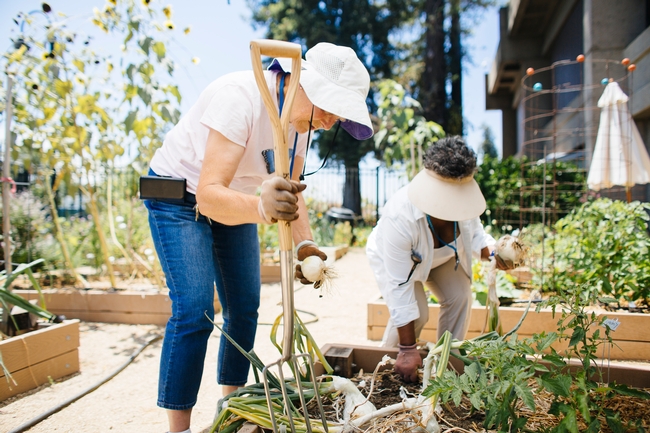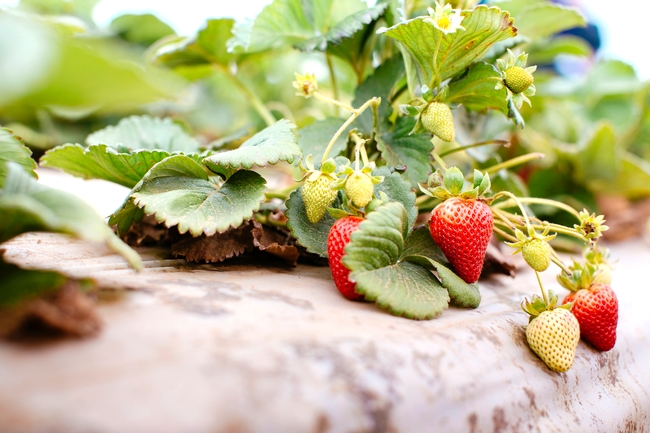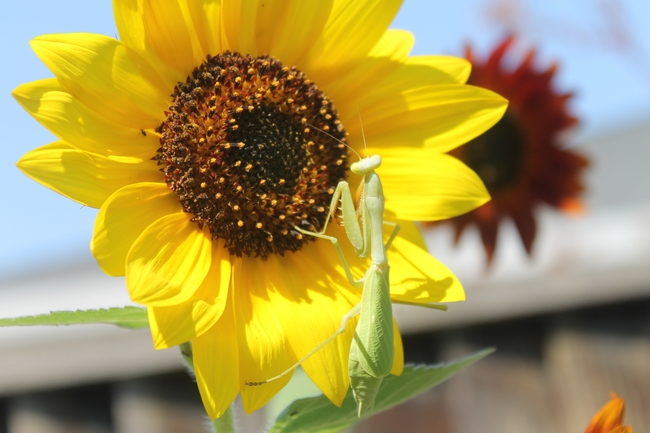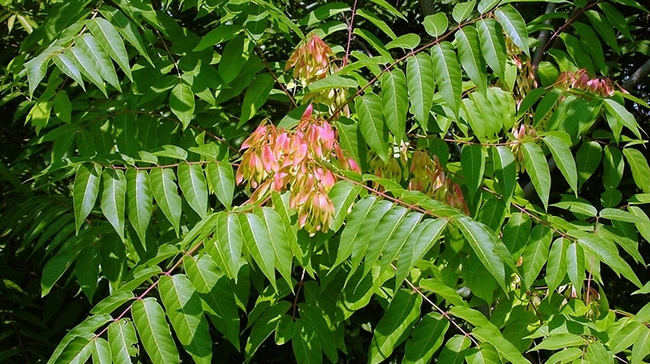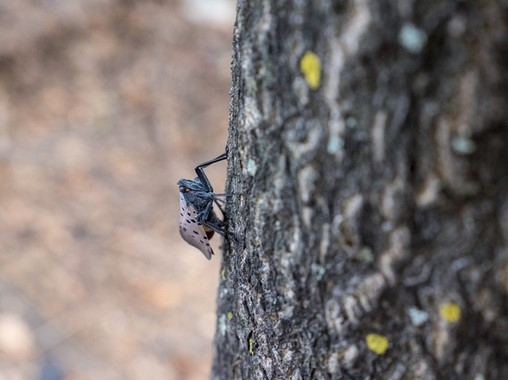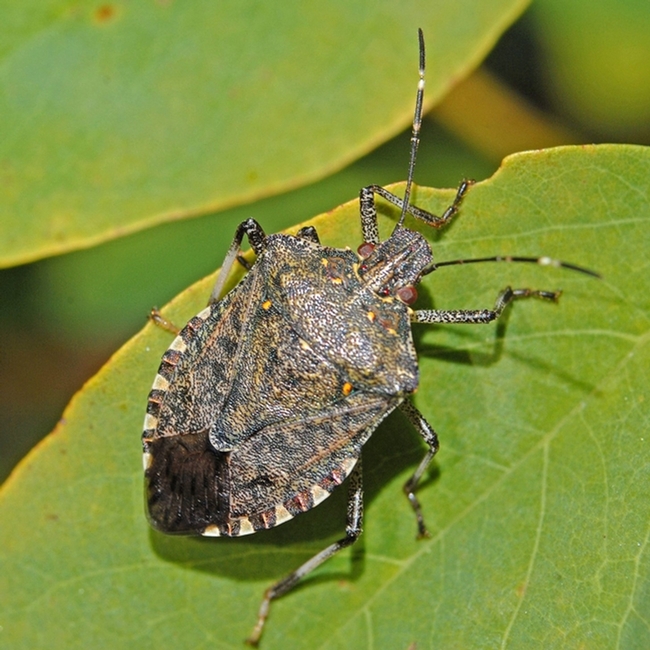In the News
Gardening in Extreme Heat with UC Master Gardener Tips to Save Your Landscape
A scorching summer heat wave is bringing triple digit temperatures and excessive heat alerts to much of California. The National Weather Service is predicting temperatures upwards of 105 and 115 degrees for several days in a row. Many home gardeners are wondering how they can help their plants, trees, or shrubs survive the intense summer heat.
“We are getting a lot of questions from around the state from people worried about how the extreme temperatures are going to affect the plants or trees in their yard,” says Missy Gable, director of the UC Master Gardener Program. “With a little extra planning, you can help your garden beat the heat and survive the hot summer weather.”
UC Master Gardener volunteers are available to help answer gardening questions and provide advice. Here are seven quick and easy ways to help make sure your plants and trees survive the hot summer months:
- Take care of yourself first, only garden during the cooler times of the day in the early morning or evening hours. Limit the time spent outdoors during the peak temperatures. Drink plenty of water, wear lightweight loose clothing, a brimmed hat, and work in the shade whenever possible.
- Shade your plants. Use a shade cloth, patio umbrella or other temporary structure to protect sensitive plants from the direct sun. This can reduce the heat stress on plants and prevent scorching of leaves.
- Water in the morning. Watering plants in the early morning helps to minimizes water loss due to evaporation, which is less prevalent during the cooler part of the day. This practice allows your plants to absorb water efficiently and become fully hydrated before the heat intensifies.
- Water trees deeply and less frequently. Water trees deeply and less frequently—yes, that's right, less frequently! The key is to water "deeply." Deep watering, promotes a robust network of deep roots, which helps the tree access water from deeper in the soil and become more drought-tolerant.
- Mulch, mulch, and more mulch. When temperatures get extreme, having a good layer of mulch prevents soil from heating up excessively and loosing water to evaporation. Apply 4-6 inches of a medium shred bark mulch to insulate the soil.
- Group container plants together: Placing container plants close to each other may help create a microclimate that retains moisture and reduces temperature fluctuations. Consider temporarily moving container plants to shadier areas.
- Watch for radiant heat. Pay special attention to plants located near walkways, patios, and other structures that radiate heat. These plants are often the first to show signs of heat stress and may require extra water to cope with the increased temperature.
- Don't fertilize plants or trees during hot summer months. Fertilizers aim to increase the growth of plants and trees. When a fertilizer is applied, especially one that is high in Nitrogen, a plant is triggered to produce more green growth. An increase in growth means an increase in water and nutrient needs. During hot spells, it is especially hard to keep up with plant water and nutrient needs as soils dry out quickly and water may not be readily available.
Thankfully,
we're not trying to garden on the surface of the sun. Unfortunately, sometimes it can feel like it. Stay cool, and don't forget to plan for your garden in the fall—it's the perfect excuse to stay inside with the air conditioning and an ice-cold beverage.
Ask your local UC Master Gardener Program
Have a gardening question? UC Master Gardener volunteers are available to help. Click here to Find a Program and connect with your local UC Master Gardener Program. You will be redirected to your local county website and contact information. UC Master Gardener volunteers are available to help answer questions for FREE. Happy gardening!
July Garden Tips - Summer Fun and Keeping Cool
As the summer sun shines brightly, July is a critical period for gardeners to nurture their plants, ensuring they thrive during the hottest part of the year. This month is a time of significant growth and harvest, where your diligent care can lead to a successful and bountiful garden. Here are gardening tips to help you make the most of your garden in July.
- Morning Watering: Water your plants early in the morning while it's still cool. This practice reduces evaporation and moisture loss, ensuring plants receive as much of the water as possible. Additionally, morning watering allows the plants to dry off before bright overhead sun exposure, reducing the risk of sunburn. Correctly irrigated plants are less susceptible to pests and diseases.
- Watering Young Plants: Closely monitor fruit and shade trees, shrubs, and perennials planted within the last year. Newly planted perennials have small root systems and are vulnerable in drought and low water conditions.. Check soil moisture regularly to prevent dehydration.
- Monitor Vegetable Plants: Wilting or drooping leaves on vegetable plants during hot afternoons do not always indicate dry soil. Check the soil moisture with a moisture probe or by digging down and water only when necessary to avoid overwatering.
- Prune Apricot and Cherry Trees: Apricot and cherry trees should be pruned in summer to avoid a fungal disease called Eutypa dieback. Prune upright growth to manage size and encourage the tree to put nutrients into fruiting branches.
- Regular Harvesting: Harvest beans, cucumbers, squash, and tomatoes at least every other day. Regular harvesting promotes further production, ensuring a continuous and bountiful supply of summer vegetables.
- Protect Tree Trunks: Apply a 50:50 mix of interior white latex paint and water to tree trunks to prevent sunscald, a condition where the bark of a tree becomes sunburned. This is particularly important for young trees, as they have not yet developed a thick bark to protect them from the sun's rays.
- Weed Control: Continue pulling weeds before they form seed heads or scatter their seeds. Consistent weeding now will reduce weed problems later in the season.
- Prune Berry Canes: After berry harvest, prune the canes that have finished flowering and bearing fruit. The canes that have not flowered and fruited should be retained. Different berries require specific pruning techniques, so know your variety and prune accordingly.
- Tomato Care: Watch for pests and diseases on your tomato plants. Maintain a consistent watering schedule to prevent issues like blossom end rot and monitor for destructive pests like the tomato hornworm caterpillar.
- Care for Roses: Prune spent flowers to encourage more blooms later in the season. Remove flowers by cutting above the first outward five-leaflet set of leaves (or lower on mature plants). Dead and crossing canes can also be removed at any time.
Ask your local UC Master Gardener Program.
Have a gardening question? UC Master Gardener volunteers are available to help. Click here to Find a Program and connect with your local UC Master Gardener Program. You will be redirected to your local county website and contact information. UC Master Gardener volunteers are available to help answer questions for FREE. Happy gardening!
Celebrate Pollinator Week with Citizen Science
Get ready to buzz with excitement because Pollinator Week is just around the corner! This international event, celebrated from June 17-23, 2024, is all about showing our support for pollinators. Pollinators are tiny heroes responsible for so much of the food we enjoy and the health of our ecosystems. All pollinators are essential to our world, from birds and bats to bees, butterflies, and beetles.
Why Pollinators Matter
Pollinators play a crucial role in agriculture, ensuring a bountiful supply of fruits, vegetables, and nuts. They help plants reproduce, which sustains our natural resources, prevents soil erosion, and aids in carbon sequestration. Imagine losing one out of every three bites of food – that's the reality we'd face without pollinators. Unfortunately, these vital creatures are increasingly at risk, and they need our help.
Join the iNaturalist Bioblitz!
The North American Pollinator Protection Campaign (NAPPC) Pollinator Communications Taskforce hosts an exciting community science bioblitz on iNaturalist to celebrate Pollinator Week. This is your chance to become a citizen scientist and contribute to necessary research on pollinator abundance and distribution across the US, Canada, and Mexico. All you need is a smartphone and a sense of adventure!
What's a Bioblitz?
A bioblitz is a fun and educational event where people come together to survey and document as many species as possible in a specific area within a set time frame. Using the iNaturalist app, participants capture and upload photos of the pollinators they encounter. The app uses image recognition technology and community verification to help identify species, creating valuable data for scientific research. This collaborative approach promotes community science by engaging a wide range of participants in documenting biodiversity, contributing to scientific research, and creating valuable datasets, all important in the UC Master Gardener Program.
Getting Started
To participate in the Pollinator Week 2024 bioblitz, you must create an INaturalist account and profile. You can use their website or their app. Then, you can start snapping photos of pollinators you see and upload them as observations to the INaturalist site or app.
Tips for Capturing Great Pollinator Photos
Taking photos of pollinators can be a bit tricky, but with these tips, you'll be snapping like a pro in no time:
- Approach slowly: Move slowly and take multiple shots as you get closer. If you have a long lens, use it to keep a distance and avoid startling the pollinator.
- Macro lens magic: To enhance your phone camera with a macro lens, hold a magnifying glass up to it. This will help you get those close-up details.
- Mind your shadow: Watch the sun's position to ensure your shadow doesn't cover the pollinator.
- Focus is key: Make sure the entire pollinator is in focus. Adjust your camera's aperture (f-stop) to get the best depth of field, and try to position yourself on the same level as your subject.
- Fast shutter speed: Use a fast shutter speed to capture quick movements, or use your phone camera's instant capture feature.
- Multiple angles: Take photos from various angles. Side, face, and wing shots are helpful for bees and flies. For butterflies, underwing photos are best, while the topside of their wings identifies moths.
Help Scientists Identify Pollinators
Understanding how scientists identify species can enhance your contributions. For insect pollinators, clear eyes, wings, and body shape images are vital. Side and above shots can reveal important details, and capturing color patterns on the abdomen or wings is especially useful for bees, beetles, and butterflies. Antenna shape is another critical feature for identification.
When uploading your observations to iNaturalist, you'll be asked for your identification suggestions, and the app will offer its own. Knowing what you've seen can help narrow down the options, especially since some insects mimic each other!
Be a Part of Something Big
Pollinator Week is more than just a celebration – it's a call to action. By participating in the iNaturalist bioblitz, you'll be contributing to the scientific community and helping protect our precious pollinators. So grab your camera, head outside, and join the fun! Let's work together to ensure a vibrant future for our ecosystems and food supply.
For more information on supporting pollinators in your garden, check with your local UC Master Gardener Program.
June Garden Tips – Keeping Up with the Busy Garden
Summer has arrived, bringing with it busier days and rising temperatures. Managing irrigation is quickly becoming the most critical task in the garden as the heat increases.
Here is a list of gardening activities to focus on this June:
- Plant Warm-Season Crops: In many parts of the state you can still plant certain warm-season crops such as beans, corn, cucumbers, pumpkins (start now for Halloween), and summer squash. These warm-season plants require substantial irrigation, so plan accordingly. Plant only as many as you can consistently water throughout the summer.
- Stake Tomatoes: Stake or cage tomato plants so they do not lay on the ground. This reduces fruit rots, makes pest management more manageable, and ensures harvesting later in the season is easy. Mulch your tomato plants to conserve soil moisture.
- Mulch: June is ideal for mulching the garden. Mulch adds a decorative touch and reduces water evaporation from the soil. It also helps control weeds, moderates soil temperature, and improves soil fertility. Maintain a 3-to 4-inch mulch depth, keeping it at least 6 inches away from the base of woody plants like trees and shrubs to prevent potentially fatal fungal growth.
- Check Watering Schedule: Regularly check soil moisture and adjust your watering habits or the schedule on your irrigation controller accordingly. Water early in the coolest part of the day to maximize water absorption through plant roots and minimize evaporation.
- Deadhead Flowers: Once you have spent flowers, deadhead roses and other summer-blooming plants to encourage continued blooming. Cut blossoms for bouquets early in the morning, as they stay fresh longer if quickly placed in a vase of water. Keep an old can or jar with water handy as you cut your stems.
- Manage Aphids: Be vigilant for any remaining aphid colonies and spray them off with water early in the day before high temperatures. This allows plants to dry quickly in the sun, reducing susceptibility to fungal diseases. Repeat applications over several days until the aphids are gone.
- Trellis Plants: Train your plants to trellises or supports as they grow. Avoid handling plants when wet from dew in the morning, as this can spread disease. Make sure the trellis you choose can handle the weight of your plant or is secured to another structure that can.
- Fire-Safe Landscaping: Implement fire-safe landscaping by following these steps:
- LEAN: Thin out dense vegetation and eliminate fuel ladders that allow fire to climb up trees.
- CLEAN: Mow grasses, trim shrubs, and remove dry, resinous, dead plants and flammable debris. Cut branches back 15 to 20 feet from buildings. Use non-combustible surfaces for walkways, patios, and driveways.
- GREEN: Landscape using low-growing, non-woody plants.
- Protect Fruit Trees: Cover fruit trees with netting to exclude birds and other vertebrate pests.
- Prune Citrus: Remove suckers at the base of citrus trees. Suckers that arise below the graft union are part of the rootstock plant. They are vigorous shoots that take water and nutrients from the rest of the plant and negatively impact your harvest. In addition to suckers, remove water sprouts, and low-hanging branches that could interfere with sprinklers or allow pests to climb into the trees.
- Enjoy Your Garden: Harvest and savor the fruits of your labor!
Following these June Garden Tips can ensure a healthy and productive garden throughout the summer.
Ask your local UC Master Gardener Program.
Have a gardening question? UC Master Gardener volunteers are available to help. Click here to Find a Program and connect with your local UC Master Gardener Program. You will be redirected to your local county website and contact information. UC Master Gardener volunteers are available to help answer questions for FREE. Happy gardening!
UC Master Gardeners part of effort to eradicate invasive tree-of-heaven
UC Master Gardeners across the state are on a scouting mission for the California Department of Food and Agriculture (CDFA), combing their communities and the local countryside to find the undesirable but common tree-of-heaven.
In contrast to its angelic name, tree-of-heaven is a noxious invasive plant that was introduced during the Gold Rush by Chinese miners who valued its medicinal properties. It is also the preferred host plant for two damaging exotic pests, the brown marmorated stink bug, already found in parts of California, and the spotted lanternfly, a leafhopper from China that officials want to keep out.
Spotted lanternflies were first detected in the U.S. in 2014 in Pennsylvania. They have since been spreading and are already found in 17 states, as far west as Illinois. Spotted lanternfly poses a significant threat to California agriculture and its natural areas, so CDFA is being proactive, organizing an effort to reduce the number of the pest's favorite host plant, tree-of-heaven.
Tree-of-heaven is found in 39 California counties, including Fresno County. It is a deciduous tree that can reach 75 feet in height with a 12-inch diameter near the base. It has smooth bark that resembles cantaloupe rind and compound leaves that contain dozens of leaflets. The tree tolerates unfavorable growing conditions on every type of topography in California below the 7,000-foot elevation. It is not an easy tree to eradicate. When cut down, it resprouts readily, creating even more trees in dense stands.
“CDFA has funding for elimination of tree-of-heaven,” said Missy Gable, director of the UC Master Gardener Statewide Program. “They need to know where the trees are located so funds can be allocated to local agencies for removal. With UC Master Gardeners' extensive training and statewide reach, they are uniquely equipped to support the project.”
More than 6,000 volunteers across the state are trained and certified UC Master Gardeners. They are dedicated to educating the public on sustainable gardening and being involved in environmental stewardship in their communities. About 300 Master Gardener volunteers have been trained to identify tree-of-heaven by assessing the bark, leaves, flowers and seeds. Using a simple online scouting tool, they will record the locations, number of trees in the stand, and the approximate diameter of the largest tree at breast height. The tool generates a map that can be used by researchers, CDFA and local public works officials to prioritize trees for removal.
If you would like more information on joining the UC Master Gardener scouting project you can watch the informational webinar here.
This article was originally posted on the UC Master Gardeners of Fresno blog.





